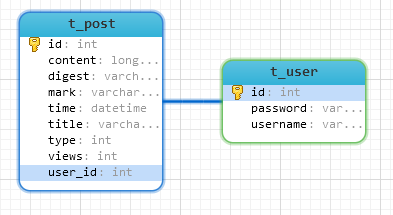首页 > 代码库 > Hibernate注解方式实现1-N双向关联
Hibernate注解方式实现1-N双向关联
由于Hibernate可以实现逆向工程,可以自动在数据库中创建表,因此这里不提供数据字典内容。
以微博或博客为例,用户和博客之间属于一对多的关系,即1-N型,在数据库中我们希望构建如下关系

创建用户实体类User:
import ***;
/**
* @author Barudisshu
*/
@Entity
@Table(name = "t_user", schema = "", catalog = "db_blog")
public class User implements Serializable {
private int id; //用户自动Id
private String username; //用户名
private String password; //密码
private Collection<Post> posts; //用户博客
@Id
@Column(name = "id", nullable = false, insertable = true, updatable = true)
public int getId() {
return id;
}
public void setId(int id) {
this.id = id;
}
@Basic
@Column(name = "username", nullable = true, insertable = true, updatable = true, length = 255)
public String getUsername() {
return username;
}
public void setUsername(String username) {
this.username = username;
}
@Basic
@Column(name = "password", nullable = true, insertable = true, updatable = true, length = 255)
public String getPassword() {
return password;
}
public void setPassword(String password) {
this.password = password;
}
//添加mappedBy属性,否则将创建中间表
@OneToMany(cascade = CascadeType.PERSIST,targetEntity = Post.class,mappedBy = "user")
@OrderBy("id")
public Collection<Post> getPosts() {
return posts;
}
public void setPosts(Collection<Post> posts) {
this.posts = posts;
}
@Override
public boolean equals(Object o) {
if (this == o) return true;
if (o == null || getClass() != o.getClass()) return false;
User user = (User) o;
if (id != user.id) return false;
if (password != null ? !password.equals(user.password) : user.password != null) return false;
if (username != null ? !username.equals(user.username) : user.username != null) return false;
return true;
}
@Override
public int hashCode() {
int result = id;
result = 31 * result + (username != null ? username.hashCode() : 0);
result = 31 * result + (password != null ? password.hashCode() : 0);
return result;
}
@Override
public String toString() {
return ToStringBuilder.reflectionToString(this);
}
}
下面为博客实体类Post:
import ***;
/**
* @author Barudisshu
*/
@Entity
@Table(name = "t_post", schema = "", catalog = "db_blog")
public class Post implements Serializable{
private int id; //博客自动Id
private String title; //博客标题
private Timestamp time; //发布时间
private String digest; //摘要
private String mark; //标记
private String content; //博客正文
private Integer type; //博客分类
private Integer views; //浏览次数
private User user; //博客用户
@Id
@Column(name = "id", nullable = false, insertable = true, updatable = true)
public int getId() {
return id;
}
public void setId(int id) {
this.id = id;
}
@Basic
@Column(name = "title", nullable = true, insertable = true, updatable = true, length = 255)
public String getTitle() {
return title;
}
public void setTitle(String title) {
this.title = title;
}
@Basic
@Column(name = "time", nullable = true, insertable = true, updatable = true)
public Timestamp getTime() {
return time;
}
public void setTime(Timestamp time) {
this.time = time;
}
@Basic
@Column(name = "digest", nullable = true, insertable = true, updatable = true, length = 1600)
public String getDigest() {
return digest;
}
public void setDigest(String digest) {
this.digest = digest;
}
@Basic
@Column(name = "mark", nullable = true, insertable = true, updatable = true, length = 255)
public String getMark() {
return mark;
}
public void setMark(String mark) {
this.mark = mark;
}
@Basic
@Column(name = "content", nullable = true, insertable = true, updatable = true, length = 2147483647)
public String getContent() {
return content;
}
public void setContent(String content) {
this.content = content;
}
@Basic
@Column(name = "type", nullable = true, insertable = true, updatable = true)
public Integer getType() {
return type;
}
public void setType(Integer type) {
this.type = type;
}
@Basic
@Column(name = "views", nullable = true, insertable = true, updatable = true)
public Integer getViews() {
return views;
}
public void setViews(Integer views) {
this.views = views;
}
@ManyToOne(cascade = CascadeType.PERSIST,targetEntity = User.class)
public User getUser() {
return user;
}
public void setUser(User user) {
this.user = user;
}
@Override
public boolean equals(Object o) {
if (this == o) return true;
if (o == null || getClass() != o.getClass()) return false;
Post post = (Post) o;
if (id != post.id) return false;
if (content != null ? !content.equals(post.content) : post.content != null) return false;
if (digest != null ? !digest.equals(post.digest) : post.digest != null) return false;
if (mark != null ? !mark.equals(post.mark) : post.mark != null) return false;
if (time != null ? !time.equals(post.time) : post.time != null) return false;
if (title != null ? !title.equals(post.title) : post.title != null) return false;
if (type != null ? !type.equals(post.type) : post.type != null) return false;
if (views != null ? !views.equals(post.views) : post.views != null) return false;
return true;
}
@Override
public int hashCode() {
int result = id;
result = 31 * result + (title != null ? title.hashCode() : 0);
result = 31 * result + (time != null ? time.hashCode() : 0);
result = 31 * result + (digest != null ? digest.hashCode() : 0);
result = 31 * result + (mark != null ? mark.hashCode() : 0);
result = 31 * result + (content != null ? content.hashCode() : 0);
result = 31 * result + (type != null ? type.hashCode() : 0);
result = 31 * result + (views != null ? views.hashCode() : 0);
return result;
}
@Override
public String toString() {
return ToStringBuilder.reflectionToString(this);
}
}
Hibernate注解方式实现1-N双向关联
声明:以上内容来自用户投稿及互联网公开渠道收集整理发布,本网站不拥有所有权,未作人工编辑处理,也不承担相关法律责任,若内容有误或涉及侵权可进行投诉: 投诉/举报 工作人员会在5个工作日内联系你,一经查实,本站将立刻删除涉嫌侵权内容。
